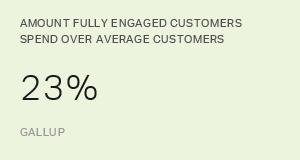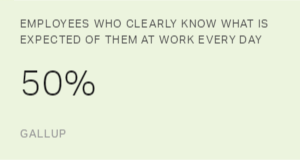Story Highlights
- Impressive 2017 holiday season for brick-and-mortar retail
- Customers spend more when they're emotionally engaged with a company
- Retailers should reconnect with their holiday shoppers during Q1
Online shopping offers convenience, not an in-person interaction -- and face-to-face interactions are what create the most lucrative kind of customers: the engaged ones.
While customers return to the stores they know, they return more often and spend more at stores that emotionally engage them.
Brick-and-mortar store owners have been watching the growth of online retail with concern -- some with outright panic.
A glimmer of hope arrived last October when American consumers told Gallup that they planned to spend more than they had during the 2016 holidays -- $121 more, on average.
And happily for store owners, shoppers spent a lot of their money in actual buildings.

Retail sales were up 0.8% in November, according to the U.S. Commerce Department, and 4.9% in December 2017, the best holiday season since 2011, according to a Mastercard SpendingPulse report.
Yes, online sales beat retail -- up 11% in 2017 from 2016, according to Adobe Digital Insights -- but people still like stores.
The theory is that consumers want to see what they buy before they lay their money down, and that's likely true.
But shopping is also a social event, and humans are social animals. The person-to-person community aspect of retail has psychological appeal to many people.
And shoppers will spend more, sometimes a lot more, when that person-to-person community feel happens in a store that focuses on customer engagement.
Focus on Your Customer Interactions Now
Data from Gallup's CE3 assessment show that customers who are fully engaged -- meaning they are emotionally and psychologically attached to a brand, product or company -- represent a 23% premium in terms of share of wallet, profitability, revenue and relationship growth over the average customer.
And, compared with actively disengaged customers -- customers who are resentful that their needs aren't being met and are acting out their unhappiness -- fully engaged customers exhibit higher revenue/sales by 51 percentage points.
Customer engagement depends a great deal on store managers and sales associates, according to Gallup studies. When managers hire talented people and engage them, these sales associates can concentrate on customers' emotional requirements.
Retail stores need to focus on these employee/customer interactions now.
Meaning right now: January, February and March.
The post-holiday doldrums offer most retail outfits time and space for training and coaching initiatives, which is helpful to the managers administering them.
But the real reason to rush to engagement is to take advantage of the rare gift the past holiday season gave retail: customers' familiarity.
This Time, With Feeling
All the brick-and-mortar shoppers became reacquainted with stores or visited them for the first time over the holidays. They know where the stores are, where they'll park, what's for sale, who they'll talk to and how much they'll spend.
That fresh familiarity means now is the time to maximize shoppers' value by engaging them.
When surveyed with Gallup's CE3 assessment, the highly engaged -- and most loyal -- customers strongly agree (rate the items with a 5) with the following statements:
- Company always delivers on what they promise.
- I feel proud to be a Company customer.
- Company is the perfect company for people like me.
Unfortunately, there's no formula you can follow to guarantee your customers' strong agreement with these statements.
This is because all employee/customer encounters are subjective, and what the associate should say or do depends on what the customer says and does.
These in-person encounters are why employee engagement paves the way for customer engagement. Engaged workers are quicker and better at responding to customers' engagement cues.
Sales associates need the freedom to act on what they perceive their customers need at every moment, and you can't script those actions.
But you can support sales associates' behaviors.
Managers need to reinforce the idea that every interaction can make customers feel proud, respected and treated with fairness.
Sales associates must honor and reinforce these emotional needs. If they do, they build engagement with every customer interaction.
Give New Meaning to "In-Store Special"
Connecting on an emotional level with customers is how retail retains in-store consumers' patronage. Only keeping them satisfied is not enough.
Satisfaction is a rational -- not emotional -- response, and it's the bare minimum any business can achieve with its customers. Businesses don't get a 51-point jump in revenue by doing the bare minimum.
Creating the right feeling in customers is not as hard as it sounds.
You can teach managers and salespeople how to do it -- that's what Gallup's CE3 is for -- as long as they understand the fact that feelings are a response to human interaction.
The primary lesson of the 2017 holiday season is that people are social animals who want what brick-and-mortar stores can offer: real-life social interaction.
At this time, those retail stores are fresh in customers' memories.
And when these customers come back in, give them three reasons to be glad they did. If you do, you'll be seeing them all year long.
Learn how Gallup can help you build long-term customer loyalty through engagement.



